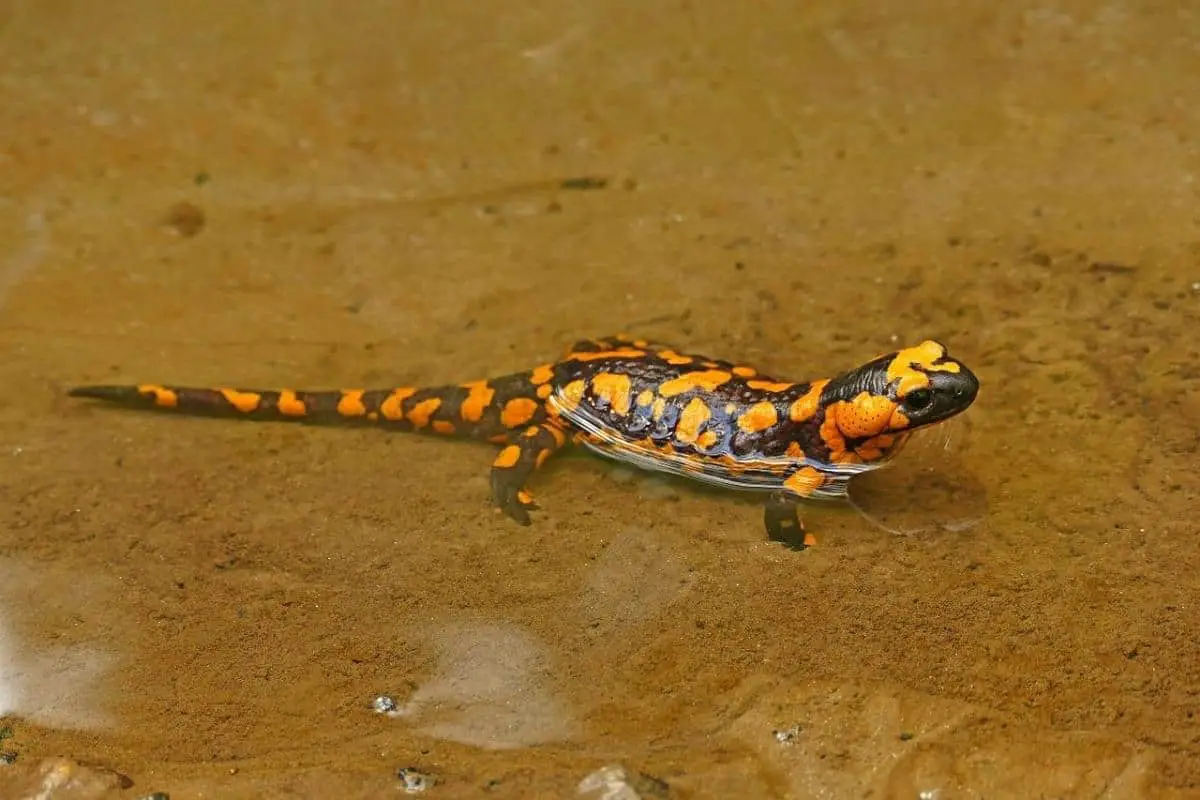There are several common amphibians found in North America, and salamanders are one of the most common. While there are more than a hundred species of salamanders, each of these species will belong to one of three distinct types. This guide will look at the three types of salamanders, in addition to some of the most common species found in North America.
21 Types of Salamanders in North America
You can find more than a hundred different species of salamanders in North America, but each of these salamanders will fall under three different types.
These types of salamanders are advanced salamanders, giant salamanders, and sirens. All salamanders are considered amphibians and are in the Caudata. While thought to be different animals, newts are also salamanders and fall under the same order.
Before looking at the most common and well-known salamander species in North America, you need to understand the difference between the three types of these amphibians. Explore the fascinating world of North American salamanders and their diverse classifications within the Caudata order.
3 main categories of salamanders
1. Advanced salamanders
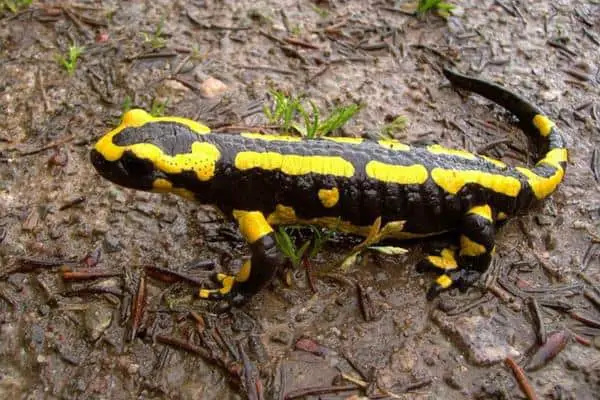
Scientific name: Salamandridae
Advanced salamanders, called Salamandridae, make up around 55 salamander species. This group itself includes true salamanders and newts, both of which are frequently found in the United States. Advanced salamanders are small amphibians, and all of them have toxins in their skin that are helpful in defending them from predators.
Newts are also poisonous if eaten by predators. Most types of advanced salamanders have fully formed lungs that they can breathe with, while other types of salamanders may have gills and be lungless.
Advanced salamander species include;
- Fire salamanders
- Kaiser’s spotted newts
- Spanish ribbed newts
- Luschan’s salamander
2. Giant salamanders
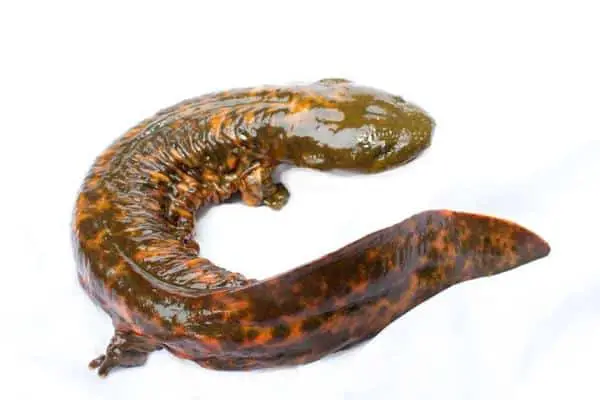
Scientific name: Dicamptodontidae
Giant salamanders are part of the Dicamptodontidae, and the largest types of land salamanders. They are more likely to be seen in the western United States and live near streams and in woodlands.
Some types of giant salamanders can get up to a few feet long. Giant salamanders are less common than advanced salamanders and sirens in North America.
Species of giant salamanders include;
- Japanese giant salamander
- Chinese giant salamander
- Pacific giant salamander
- Hellbender
3. Sirens
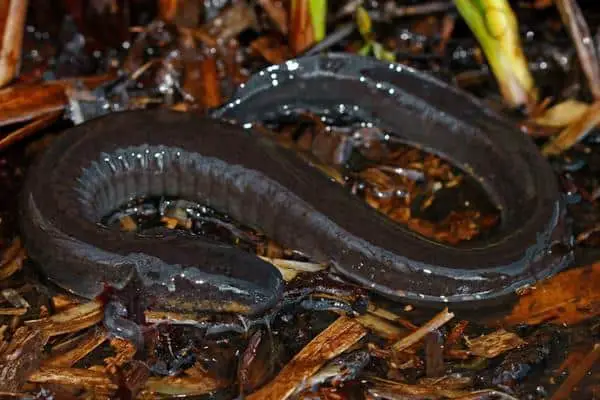
Scientific name: Sirenoidea
Sirenoidea salamanders, called sirens, are from the Sirenidae family. These salamanders do not experience a full metamorphosis from larval to adult, but instead, go through a paedomorphosis.
This means that as adults, siren salamanders have lungs and gills that they can breathe with. They also use a horned beak instead of teeth, and do not have hind legs.
Types of siren salamanders include;
- Reticulated sirens
- Dwarf sirens
- Greater sirens
- Lesser sirens
21 examples of salamanders in North America
In North America, there are over one hundred species of salamanders, from sirens to advanced salamanders. These amphibians can be found from Mexico to Alaska and along both the east and west coasts of the United States.
These amphibians mainly feed on what is considered pest animals, such as mosquitos, ticks, and flies. They will also eat worms, spiders, or fish.
This guide will look at 21 of the most common salamanders in North America.
1. Eastern tiger salamander

Scientific name: Ambystoma tigrinum
The eastern tiger salamander can be frequently spotted in areas throughout North America. They thrive in marshes, forests, and wetlands, and prefer to live near ponds.
These salamanders also create burrows underground where they spend a lot of their time. Eastern tiger salamanders have one of the widest distributions of any other North American salamander.
They have thick bodies with dark skin and yellow markings. These amphibians can be found from Mexico to Alaska and Canada. Despite having such a wide range, these salamanders are listed as endangered.
2. Eastern newt
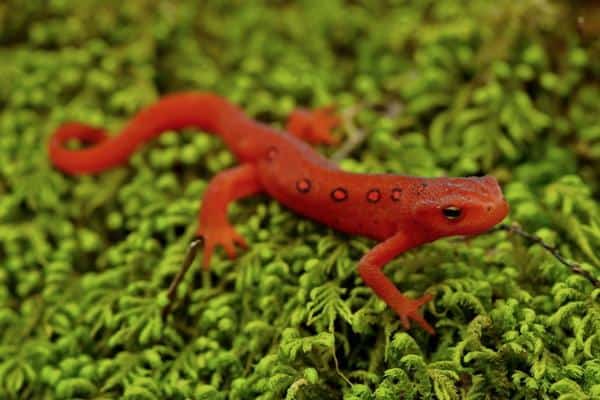
Scientific name: Notophthalmus viridescens
The eastern newt is common throughout many areas of North America but is more common in the east, which is where their name comes from. These are one of the six types of newts found in North America.
They are born in ponds but will spend many years exploring forests. This happens during what is called the red-eft stage, but some eastern newts do not go through this phase of life. They are closely related to western newts, which are common along the west coast.
3. Hellbender
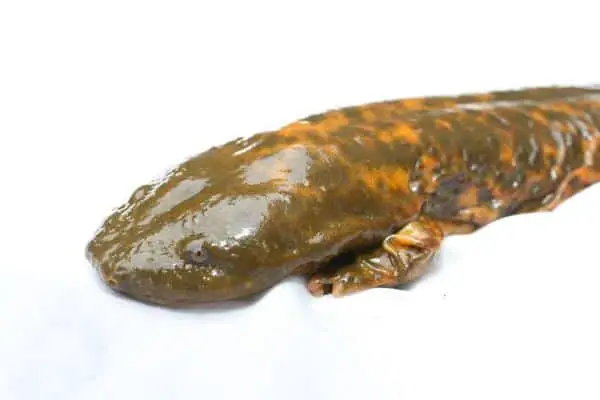
Scientific name: Cryptobranchus alleganiensis
One of the least commonly seen salamanders in North America is the hellbender. They aren’t considered common, but they’re very interesting and worth including on this list.
These giant salamanders are very elusive and have stout legs with a flat tail that looks like a rudder, which is helpful when they need to swim. Hellbenders are aquatic and spend almost their entire lives in the water.
They tend to have gray or dark colorings and are sometimes seen with peppered black spots. The lower sides of these salamanders have loose flaps of skin hanging from them, adding to the distinctive features of the salamanders of North America.
4. Mudpuppy

Scientific name: Necturus maculosus maculosus
Mudpuppies are commonly referred to as waterdogs, and can be recognized by their set of feathery gills. They have short legs and a tail fin that helps them quickly swim through water.
Mudpuppies have four toes on their front and hind feet, while many other types of salamanders have five toes. These salamanders are usually gray with a pale belly.
5. Two-toed Amphiuma

Scientific name: Amphiuma means
The two-toed Amphiuma are some of the most widespread salamanders found in North America. Unlike most other salamanders, these are known for only having two toes.
Most other salamanders found in the U.S. have five toes, but certain types are known for having less. The two-toed Amphiuma is more likely to be seen along the coasts of North Carolina, South Carolina, and Georgia. They can also be found throughout the state of Florida.
6. Three-toed Amphiuma
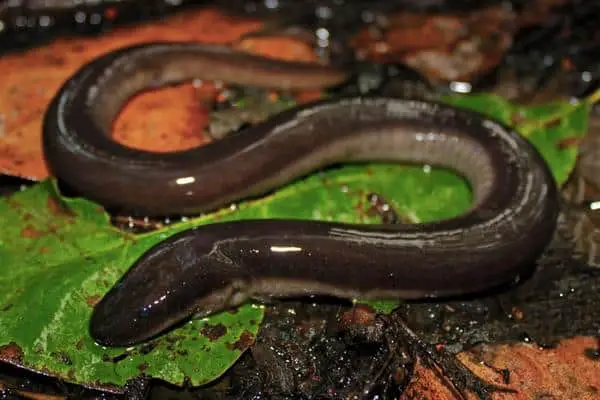
Scientific name: Amphiuma tridactylum
The three-toed Amphiuma is closely related to the two-toed Amphiuma. Most salamanders have five toes but, as their name suggests, the three-toed Amphiuma only has three toes.
These salamanders can get as big as three feet, making them the longest salamanders found in the U.S. They are actually the longest of any amphibian in all of North America.
7. Jefferson Salamander
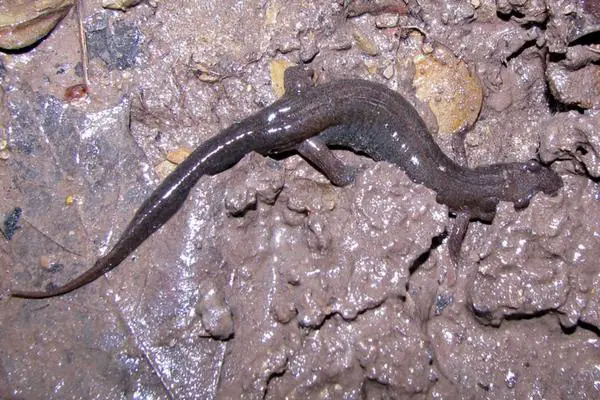
Scientific name: Ambystoma jeffersonianum
Jefferson salamanders are a long and slender salamander frequently spotted throughout the United States. They are known for having long toes and a long snout, with 12 coastal grooves down each of their sides.
Jefferson salamanders are brownish gray, with blue marks around their heads. However, older Jefferson salamanders might not have these marks at all, as they disappear over time.
8. Marbled Salamander
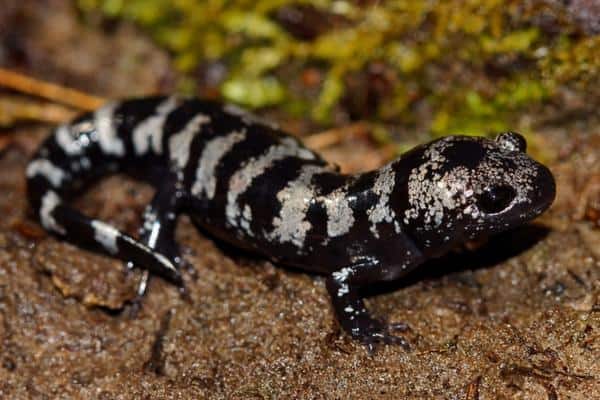
Scientific name: Ambystoma opacum
Marbled salamanders found in the United States are typically dark black or brown, with crossbands that are white. Female marbled salamanders might have darker crossbands. These salamanders can have either 11 or 12 coastal grooves, with a completely black underbelly.
9. Spotted Salamander
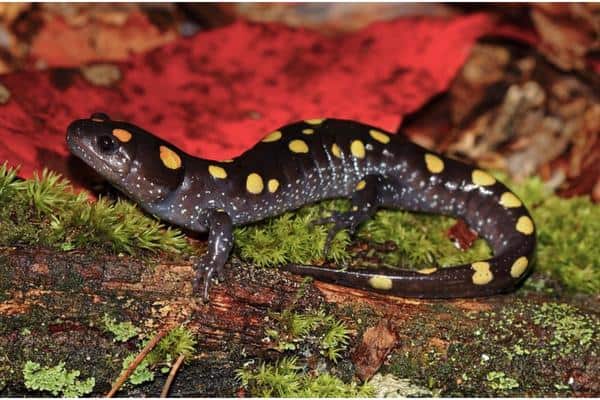
Scientific name: Ambystoma maculatum
One of the most recognizable salamanders in North America is the spotted salamander. They have two rows of either orange or yellow spots running down their bodies, while the rest of them is typically a dark blue, black, or brown. Spotted salamanders also have 12 coastal grooves down each side.
10. Red Spotted Newt
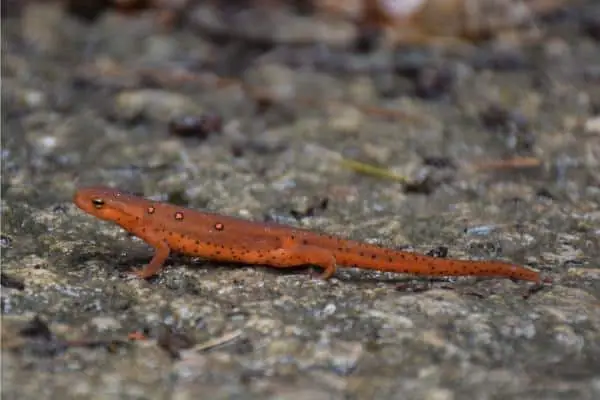
Scientific name: Notophthalmus viridescens
Just as the name suggests, the red-spotted newts can be recognized by red spots that mark their brown colored bodies. As larval, red-spotted newts are more greenish, and they at first have forelegs and gills.
They will develop hind legs and the rest of their forelegs after a few months, and they will lose their gills. This metamorphosis also causes them to develop a rudder-like tail, which helps them as they spend the rest of their life in the water. Coastal grooves on these salamanders are hard to notice.
11. Northern Dusky Salamander
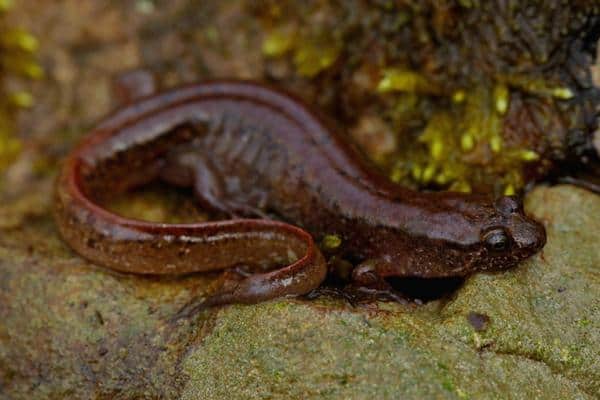
Scientific name: Desmognathus fuscus fuscus
Northern dusky salamanders have 14 distinguishable coastal grooves going down each of their sides. Their tail is less than half of their size and triangular shaped.
The northern dusky salamander looks completely gray or tan but sometimes has nearly unnoticeable dark markings. These salamanders have a light colored underbelly with blueish speckles.
12. Green Salamander
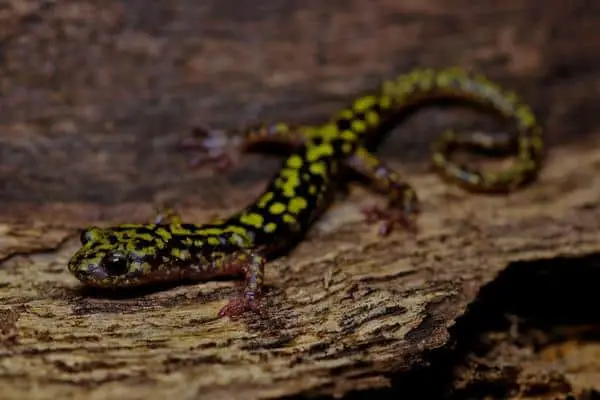
Scientific name: Aneides aeneus
The green salamander is considered threatened in North America. It can be recognized by a large head that is said to look swollen, and irregular yellowish patches dotting green skin. Green salamanders have a slender and flat body with square-tipped toes. They also have either 14 or 15 coastal grooves on each of their sides.
13. Northern Two-Lined Salamander

Scientific name: Eurycea bislineata bislineata
While the northern two-lined salamanders will usually appear yellow or brown, they also have a light stripe that runs down most of their back. Down their tail, this stripe may be broken into multiple sections.
Each side of these salamanders can have between 13 and 16 coastal grooves. Northern two-lined salamanders also have a bright yellowish belly.
14. Appalachian Dusky Salamander
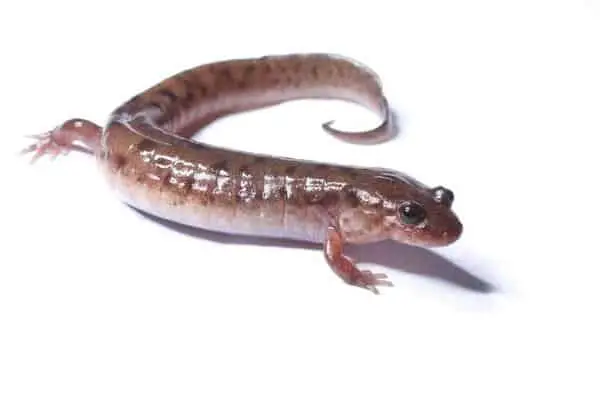
Scientific name: Desmognathus monticola
Appalachian dusky salamanders are closely related to the northern dusky salamander, and they can look pretty similar. Half of their size is their tail, and they are usually gray or light brown.
They also have streaks of black or brown going down their backs. Appalachian dusky salamanders will have 14 grooves down each side, and the very tip of their tail will end in a point.
15. Mountain Dusky Salamander
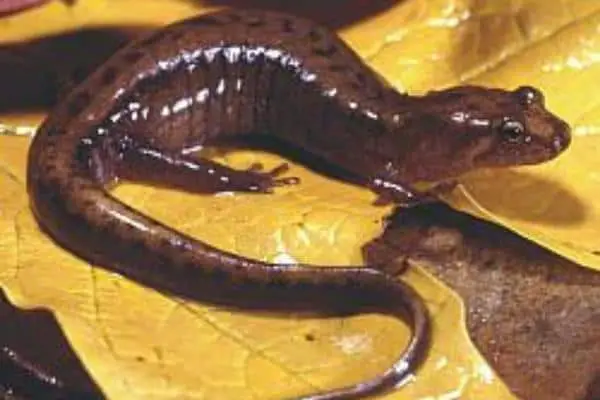
Scientific name: Desmognathus ochrophaeus
One of the common salamanders spotted throughout the United States is the mountain dusky salamander. They blend into the ground thanks to their dark brown or tan coloring and have light stripes running down their backs.
The face of mountain dusky salamanders will also have a line from their jaw to their eye. These salamanders have 14 coastal grooves on each side and a rounded tail.
16. Four-Toed Salamander

Scientific name: Hemidactylium scutatum
Most of the salamanders found throughout North America have five toes, but the four-toed salamander only has four toes on their forelegs and hind legs.
They can be a red, brown, or yellow color with gray sides and black spots. These salamanders are also known for having thick tails with a ring around the base of it.
17. Longtail Salamander
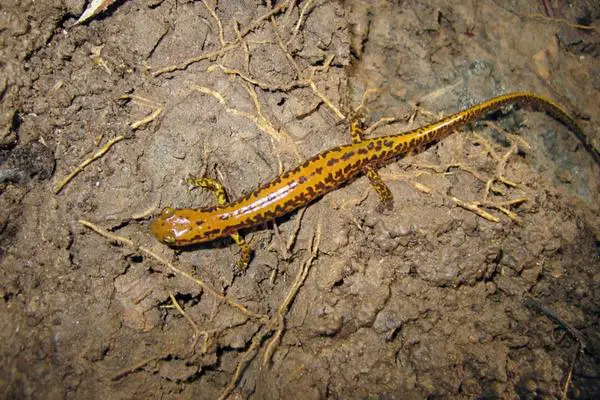
Scientific name: Eurycea longicauda longicauda
Just as the name suggests, the longtail salamander has a tail that is longer than the rest of its body. These bright yellow salamanders are common in the United States.
They can be recognized by their bright coloring combined with dark spots speckling their body. Down their tails, these spots can appear more like lines.
18. Slimy Salamander
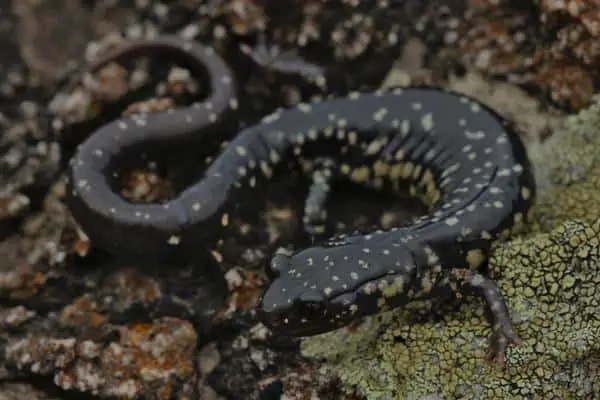
Scientific name: Plethodon glutinosus glutinosus
Slimy salamanders will have 16 coastal grooves down each of their sides, and shiny black skin marked with silver or white spots. The throats and chins of these salamanders are dark gray, while their bellies are a slate color. The slimy salamander is commonly seen in the United States, especially in Appalachian regions.
19. Redback Salamander

Scientific name: Plethodon cinereus
The redback salamander is one of the lungless salamanders that is frequently seen in areas throughout the United States. These are slender and long salamanders, recognized by the red coloring of their backs. This thick mark can sometimes be gray, pink, orange, or yellow instead of red.
These salamanders can go through three different color phases, with the redback being the second phase. The first phase is called the lead back phase. In this phase, they look fully black or gray. The third phase is rarer and features the redback salamander being fully red, except for on their bellies. They can have between 18 and 20 coastal grooves going down each of their sides.
20. Northern Red Salamander
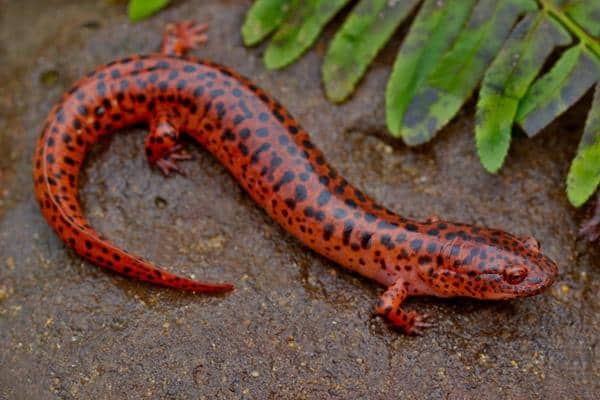
Scientific name: Pseudotriton ruber ruber
You can count anywhere from 16 to 17 coastal grooves down each side of the northern red salamander. Their bodies are typically red or orangish and marked with black spots. Adult northern red salamanders are usually dark than juvenile salamanders.
21. Wehrle’s Salamander
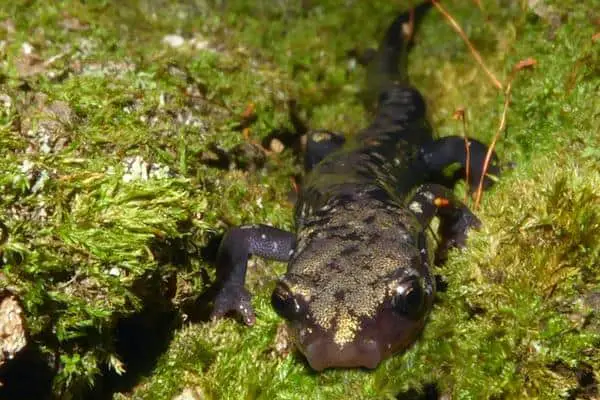
Scientific name: Plethodon wehrlei
The Wehrle’s salamander spotted throughout the United States can look anywhere from a bluish color to black, with small light flecks sometimes decorating their backs. They have 17 coastal grooves down each of their sides, and a gray underbelly. Their throats are typically white.
Conclusion
While you may find over a hundred different species of salamanders in North America, these above 21 are some of the ones you are most likely to come across. These amphibians have a range reaching from the east coast to the west coast, and from Mexico to Canada.
